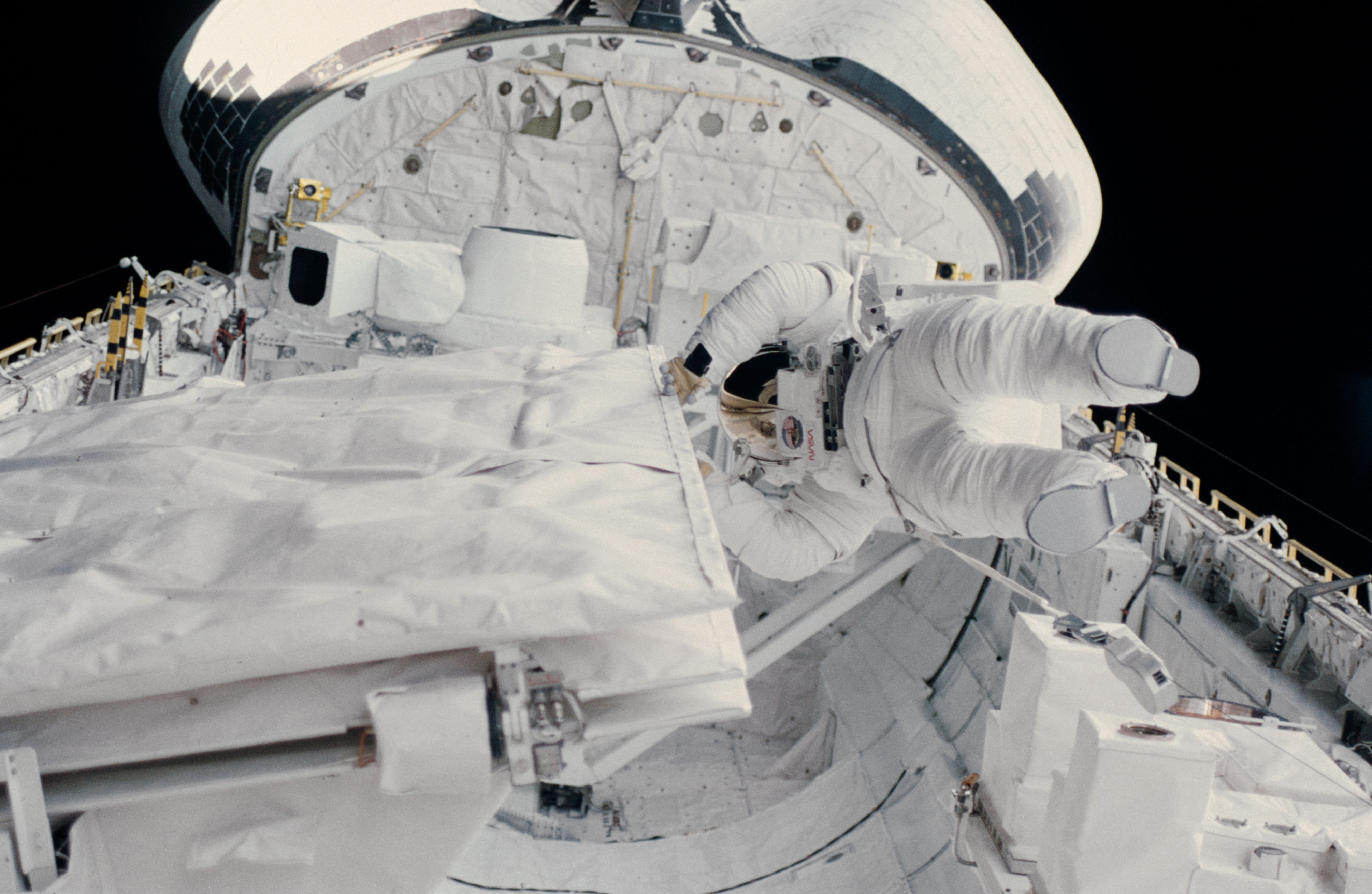
Thirty years ago, this week, on 5 October 1984, history was made when Shuttle Challenger rocketed into orbit on Mission 41G, an ambitious science and technology flight. On-board was the largest crew ever launched—a seven-strong team, commanded by veteran shuttle flier Bob Crippen—which included the first U.S. woman to embark on a second spaceflight, the first U.S. female spacewalker, Canada’s first man in space, and the first Australian-born astronaut. During their eight days aloft, the crew of 41G deployed a large Earth resources satellite, imaged the Home Planet with powerful synthetic aperture radar, and embarked on a risky EVA to rehearse techniques for the on-orbit fueling of future spacecraft.
The NASA “core” crew of Crippen, pilot Jon McBride and mission specialists Kathy Sullivan, Sally Ride, and Dave Leestma had been named in November 1983, with the intention that they would launch aboard Columbia as STS-17 in August 1984. They would deploy the Earth Radiation Budget Satellite (ERBS) and operate an expansive payload called “OSTA-3,” provided by NASA’s Office of Space and Terrestrial Applications. It promised to be an exciting mission, but caused a problem, for Crippen was halfway through training for another flight, the 41C capture and repair of Solar Max, planned for April 1984. It meant that he would be unable to join the 41G crew until late in their training regime.
As a result, Sally Ride—who had flown with Crippen on STS-7 and knew how he liked to run a mission—oversaw the training of the rest of the crew until he became available. She served as a surrogate commander, shepherding the rookies through their training until Crippen joined them in late April 1984. By the time 41G took place, it had also picked up a pair of payload specialists: Paul Scully-Power, an Australian-born oceanographer, employed by the U.S. Navy, and Marc Garneau, who became Canada’s first man in space.
Unlike several other missions in 1984, which suffered delays due to booster problems, 41G kept its cargo and its approximate place in the shuttle launch manifest, because ERBS and OSTA-3 were unique payloads. “It was sure exciting to see our flight kind of hold its position while others slipped,” Dave Leestma told the NASA oral historian, “because we figured, as they slipped, then we’d slip. But because of the requirements of our payload, we had to fly at a certain time of the year and a certain inclination.” This also made Leestma the first member of his astronaut class (selected in May 1980) to fly a mission.
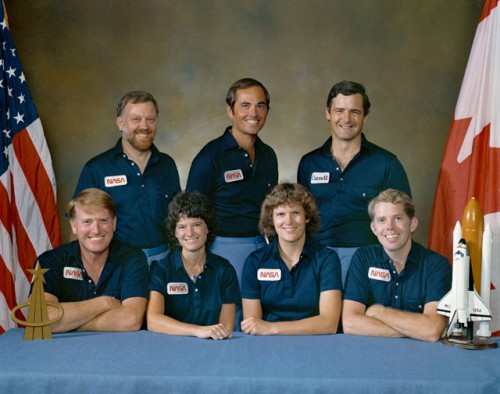
Years later, Leestma wondered if having a fellow mission specialist (Ride) help train them, in place of a temporarily absent commander, was being deliberately done to assess its effect upon crew preparations. At this stage, in the pre-51L era, NASA was actively looking at flying astronauts two or three times per year and 41G’s training cycle gathered valuable, “real-world” data in support of this goal. Having said this, in his 1987 book, Before Liftoff, journalist Henry S.F. Cooper, Jr., wrote that using Crippen so often—he had already flown STS-7 in June 1983, 41C in April 1984, and would lead 41G in October 1984—went against the grain of building a pool of experienced astronauts. In Cooper’s mind, the building of such a pool was “essential if [NASA] is ever to achieve a rate of one flight a month.”
In addition to marking the second flight of Ride, 41G would also include the first EVA by a U.S. female astronaut, Kathy Sullivan. In the eyes of the media, the pair become unofficial spokespeople for the crew. “Jon and I could easily just stand in the background and be just one of the crew,” joked Leestma. “It took a lot of the spotlight off us, which was fine.” By the late summer of 1984, with Crippen having finally joined them, the crew averaged 80-90-hour working weeks in the simulator, tracking an early October liftoff.
Original plans called for a late August launch, but originally they were assigned to fly Columbia. Her additional cryogenic oxygen and hydrogen tankage allowed a longer-duration mission than was possible by her sisters, Challenger and Discovery, and NASA’s manifests from November 1983 and January 1984 show her flying 41G for 10 days. Unfortunately, problems arose when she began a period of modification at Rockwell International’s facility in Palmdale, Calif., and repairs and upgrades took longer than anticipated. NASA managers began to consider the roomier Challenger as a more attractive alternative, particularly in view of the large 41G crew.
For the astronauts, Columbia was preferable in terms of her ability to remain in space for longer, but it was hoped that 41G would perform a landing at the swamp-fringed Shuttle Landing Facility (SLF) at the Kennedy Space Center (KSC). Unlike Challenger, Columbia did not yet have a Heads-Up Display (HUD), which would have enabled to make such a precision touchdown with confidence. In fact, Flight International explained in May 1984 that a Columbia-flown Mission 41G would be forced to land at Edwards Air Force Base, Calif., due to the absence of the HUD. Landings in Florida were highly desirable, as NASA sought to make shuttle flights “routine,” and when its May 1984 manifest was released it was official: 41G would fly on Challenger, although the mission would be shortened from 10 to eight days.
Within weeks of returning from 41C, Bob Crippen asked the instructors to schedule himself and his new crew for a fully-integrated simulation on 8 May. Normally, such “sims” involved not just the astronauts, but also the whole flight control team for the mission, and were only undertaken in the last eight weeks before liftoff. It proceeded smoothly. By this point, Crippen had three shuttle flights under his belt and was the most experienced astronaut in training at the time. “With Crippen there, we had a harder time fooling the crew,” lead instructor Ted Browder told Henry S.F. Cooper. “Crippen has seen about every training scenario there is!”
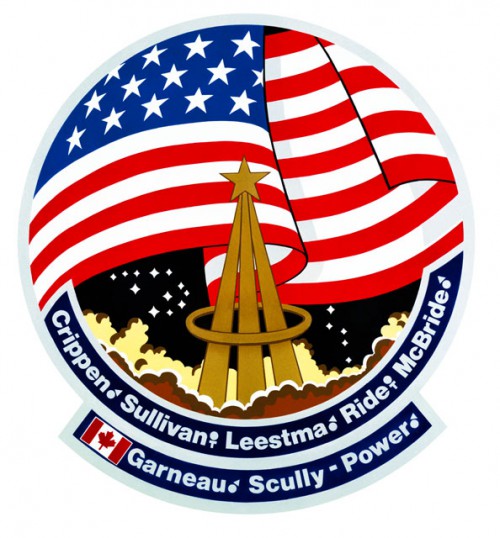
Also in May, payload specialists Scully-Power and Garneau joined the crew, expanding it to become the largest team of spacefarers ever launched aboard a single spacecraft. The former, nicknamed “PSP” by the crew and labeled “a little bit of a loose cannon” by Crippen, only flew because the prime payload specialist, oceanographer Bob Stevenson, had resigned his place to care for his cancer-stricken wife. She died a few days before 41G launched. “The funeral was the day of the launch,” Stevenson remembered. “The whole crew called me from the crew quarters that morning. They sent a beautiful arrangement; all orchids.”
The relatively late arrival of the payload specialists caused concern, particularly for Kathy Sullivan, who felt the five-strong NASA “core” crew had by now knitted itself into a team. “And then there’s this other guy,” she said of Scully-Power, “who’s being advertised as The Oceanographer. Excuse me, I have a PhD in this subject. This guy has a bachelor’s degree!” At the very least, Scully-Power became the first person to venture into orbit, aboard a U.S. spacecraft, wearing a beard. …
Not only the high inclination (57 degrees to the equator, enabling the crew to “see” much of Earth’s surface) but also the altitude of 220 miles (350 km) would be unusual, for the astronauts would adjust Challenger’s orbit in order to support two very different payloads. The large ERBS satellite sought to explore the impact of solar radiation on our planet, including its absorption and re-emission by the atmosphere. When NASA began developing ERBS in 1978, the agency hoped it would provide a clearer understanding of the radiation “balance” between the Sun, Earth, atmosphere, and space. This, in turn, would expand knowledge of the mechanisms responsible for terrestrial weather and climatic change. It was strange-looking machine, but to Dave Leestma it was “a beautiful satellite, coated with gold foil insulation and dark, purplish-blue solar arrays,” and would be deployed by Ride using Challenger’s Canadian-built Remote Manipulator System (RMS) robotic arm.
After a perfect, on-time launch at 7:03 a.m. EST on 5 October 1984, which, according to Sullivan, was a “huge, huge vibration spectrum” with “tons of noise,” the ERBS deployment effort got immediately underway. Its systems were activated, pre-deployment checks executed, and, with the satellite held high above the payload bay, the procedure to extend the solar arrays and other appendages (including communications hardware) got underway. “The solar arrays,” said Leestma, “were folded up to the sides of the satellite, so we were getting ready to put them out and the ground checked to make sure they were getting current and everything was powered up and looking good.”
All five NASA crew members, by this time, were crowded into Challenger’s tiny flight deck: Ride and Leestma at the RMS controls, Sullivan handling the cameras, McBride flying the spacecraft, and Crippen, in his own words, “sitting back and managing.” Scully-Power and Garneau were confined to the middeck. Through their headsets, the crew heard the voice of Capcom Dave Hilmers, telling them to release the arrays. “We sent the command for the first solar array to deploy and it went up,” said Leestma, “but when we hit the command for the second one, nothing happened!”
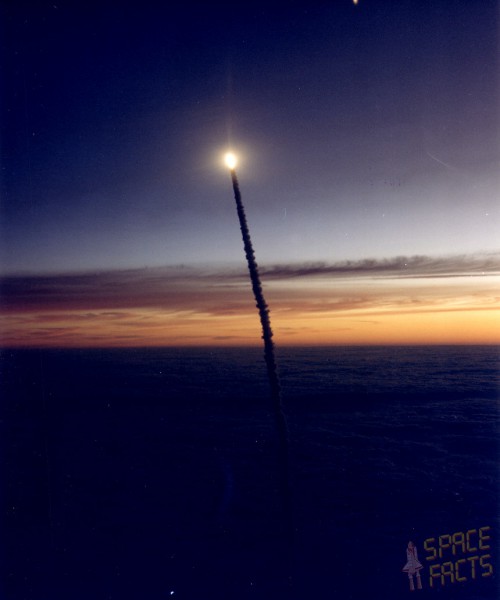
Several more tries, including one initiated from the ground, to unfurl the stubborn array were also fruitless. Next, they attempted to “jostle” ERBS by rolling the RMS end effector, without success, and finally McBride oriented Challenger’s payload bay toward the Sun to thaw out possibly frozen hinges. “We were talking inside the cabin, of course, about what we could do to free this solar wing,” Leestma continued. “This was back before we had all the TDRS coverage, so we went through long periods of time where we didn’t have to talk to the ground or they couldn’t see data. We were getting ready to come up over Australia and through the Canberra station and talk to the ground and then we would have a 15-20 minute period before we’d come up over the States; a big loss of signal time.”
As the crew awaited the reacquisition of signal, Ride and Leestma considered trying again to shake the array open with the RMS. “We changed the payload identification, which tells the arm what’s on the end of it,” said Leestma, “and changed the payload in the software to ‘zero’, which meant there was nothing on the end of the arm. Now we could go to the max rates on the arm and play with it.” After receiving authorization from Crippen—on condition that they did not break ERBS—Ride jerked the arm as sharply as possible from left to right and back again. During her second attempt, Leestma suddenly noticed something move. Ride put the satellite back into its deployment position and the array slowly juddered, then stopped, juddered again, and finally sprung open.
“We came up over the States,” Leestma exulted, “the ground said ‘Okay, we’re with you’. I don’t remember the exact quote, but they asked ‘What did you guys do?’ We said ‘We aren’t going to tell you, but just check it out and make sure that it’s ready to deploy’.” The glitch, which was later attributed to “thermally-induced problems,” delayed ERBS’ deployment from Challenger’s sixth orbit to her ninth circuit of the globe. During this time, controllers at NASA’s Goddard Space Flight Center in Greenbelt, Md., uplinked new telemetry data to the satellite to activate its attitude control system. For Bill Holmberg, the keeper of 41G’s crew activity timeline for the mission, their carefully choreographed, minute-by-minute schedule had been swept into disarray. However, he later told Henry S.F. Cooper that it was easier to rewrite an already extant plan than to write a new one from scratch.
After the satellite left the RMS at 6:18:22 p.m. EST, Crippen and McBride pulsed Challenger’s thrusters to separate and, two days later, ERBS made the first of a series of thruster firings to raise its orbit to 350 miles (560 km). The next problem cropped up almost immediately, when the crew began operations with their other major payload, the second flight of the Shuttle Imaging Radar (SIR-B), part of the OSTA-3 package, which experienced difficulties transmitting data through Challenger’s Ku-band antenna. This had already proved to be something of a headache in pre-mission simulations because of its flimsy nature. Some scientists wanted it to commence radar observations of Earth while Challenger was at her ERBS-deployment altitude and continue doing so while she lowered her orbit to SIR-B’s 160-mile (260 km) operating altitude.
However, reducing the shuttle’s orbit required two Orbital Maneuvering System (OMS) “burns” and it was feared that the shock could impart structural damage to the radar. On its first flight, STS-2 in November 1981, SIR had amply demonstrated its unique ability to gather data in support of geographical, geological, hydrological, oceanographic, vegetation, and ice-monitoring applications, by acquiring imagery of more than 15.4 million square miles (40 million square km) at resolutions as fine as just 130 feet (40 meters). During typical science-gathering activities, it radiated pulses of energy and measured the characteristics of the reflected “echoes” from the surface. Its STS-2 data had allowed for the construction of 3-D models of subtle geological features on California’s Mount Shasta, as well as contour mapping of eastern and southern Africa.
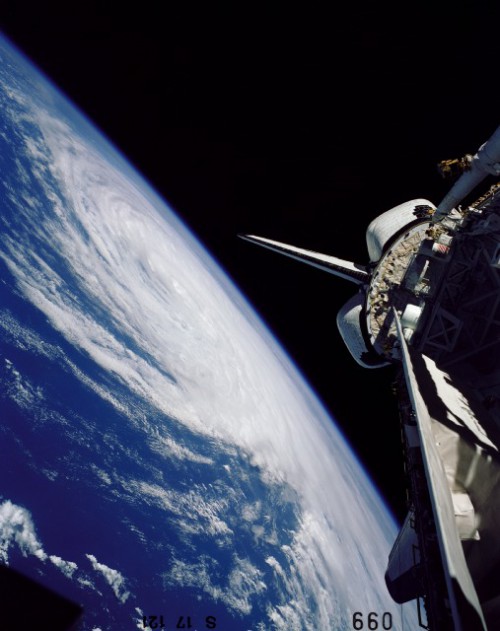
Shortly before ending their first day in space, the crew deployed the radar and, for about two minutes, it began transmitting scientific data through the Ku-band antenna via the first Tracking and Data Relay Satellite (TDRS-1) to the ground terminal in White Sands, N.M. Then, abruptly, it stopped. Engineering analysis quickly determined that the antenna had lost its “lock” on the geostationary TDRS, due to a failed motor in its “beta” gimbal. One axis by which the Ku-band dish could move was effectively dead and the other—the “alpha” gimbal—swung backwards and forward, operating sporadically.
To correct the gimbal problem, Mission Control directed Ride and Leestma onto Challenger’s middeck to unplug a wire that routed power to the antenna’s motors. It was hoped that, if the wire was removed at the correct time, just as it swung out at right angles to the spacecraft, the astronauts could reorient Challenger such that the Ku-band was refocused on TDRS-1. The wire was situated behind a row of lockers, so after the astronauts had removed them they waited for Crippen to announce the right time to unplug the wire. Peering at the waving antenna through the aft flight deck windows, as soon as it looked to be in the proper position, Crippen told Ride to pull the wire. The Ku-band antenna stopped its erratic motions and could thenceforth only move slightly in response to external forces, such as thruster firings which maneuvered the entire vehicle.
At this point, Sullivan retracted the delicate radar to enable Crippen and McBride to lower their ship’s orbit to 160 miles (260 km). Using controls on the aft flight deck, she attempted to fold the two outermost antenna “leaves” onto the central section and close the assembly into a storage canister. It should have gone smoothly, but as she watched the clunking radar components through the window it became clear that SIR-B was improperly stowed. Sullivan tried shutting it with backup controls, without success. A third option was to fire pyrotechnics, thus slamming it closed, but rendering it impossible to re-open. Flight rules dictated that the antenna had to be closed before an OMS burn could take place, for fear that it might be damaged during the orbit-lowering maneuver. Already, when she first deployed SIR-B, Sullivan had noticed that it wiggled around in what Henry S.F. Cooper later described as “a classic case of dynamic instability.” It seemed likely that if they conducted the OMS maneuver with the antenna still partially open, this would inflict damage.
Sally Ride’s dexterous handling of the RMS proved the savior of the day, when she employed its end effector to push the antenna leaves firmly into place. Mission Control was unhappy with this technique, because there was no way of accurately gauging the amount of force imposed on the fragile panels, but neither the arm, nor the radar, appeared dented or scraped. Ride also earned brownie points with Leestma and Sullivan, whose 3.5-hour EVA, scheduled for 9 October and later delayed until the 11th, might have been cancelled if SIR-B had not been latched back into place.
One of the objectives of the spacewalk was to test hardware for the refueling of satellites in low-Earth orbit. Mounted at the rear end of the payload bay was the Orbital Refueling System (ORS), containing 175 pounds (80 kg) of highly-toxic hydrazine, some of which the spacewalkers would transfer between two spherical tanks. “Satellites have standard refueling ports that engineers connect up when they’re on the ground,” explained Leestma. “One at a time, you very carefully have to handle the hypergolic fuels that go into it, because they’re pretty dangerous. Hydrazine is very much like water, but it’s got different properties, one of which is that it blows up if it’s not handled right! Crip and the safety folks were very concerned that we shouldn’t do this with hydrazine; we should just do it with water.”
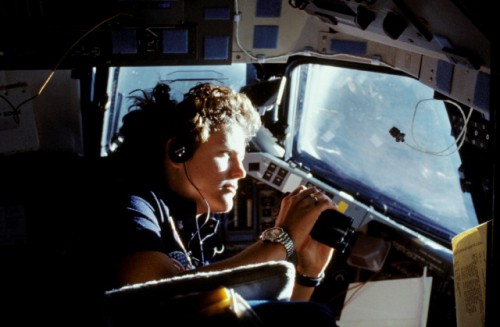
Having studied hydrazine “detonation” tests at length, Leestma was keenly aware of its dangers. “You can’t breathe it,” he explained. “If you get it on your skin, you can get poisoned. There were concerns that if we used hydrazine and it sprung a leak or even got on our suits, how are we going to get back in the airlock? We didn’t want to bring this stuff back in.” Crippen also knew that hydrazine could prove explosive at temperatures above 230 degrees Celsius (450 degrees Fahrenheit), which could easily be surpassed in the intense sunlight of orbital daytime. On the other hand, during orbital darkness, it could freeze, contract, flow back, and over-pressurize and rupture its fuel lines. If Leestma and Sullivan got it on their suits, Crippen would need to orient Challenger toward the Sun to “bake” it out. The spacewalkers would then have to scrub their suits with towels and detergent, seal them into airtight bags, purge the airlock’s atmosphere, and pipe in fresh air. Only then could they safely remove their helmets.
Crippen was also worried that 175 pounds (80 kg) of hydrazine might “take off the back end of the vehicle” if it exploded. He flatly wanted to use water, but was overruled. NASA managers felt that only using the real thing would it be possible to test safety procedures, adding that the ORS tanks had been designed to be robust to shocks. At length, after watching Leestma perform the task in the Weightless Environment Training Facility (WET-F), and seeing the triple containment of all liquids at all times, Crippen was won over. However, in some minds, the 41G hydrazine tests presented another indication of NASA’s over-confidence in the shuttle’s capabilities and a growing cavalier attitude toward safety.
The second part of this article will appear tomorrow.
Want to keep up-to-date with all things space? Be sure to “Like” AmericaSpace on Facebook and follow us on Twitter: @AmericaSpace




Good article, as usual. 41-G was an early demonstration of the science that the Shuttke was capable of.
One question about the hydrazine leak procedure: how would they have doffed, scrubbed and bagged their suits, the EMUs, while still wearing their helmets? The helmet is attached to the suit at the neck ring and cannot seal independently of the suit.